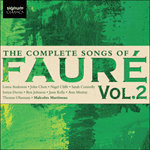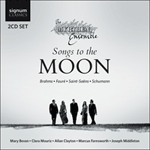Fauré’s
Barcarolle is to his
Tarentelle as Liszt’s languid
Venezia is to his energetic
Napoli (in the
Années de pèlerinage), or Mendelssohn’s brooding
Gondellied to the joyful
Saltarella of the ‘Italian’ Symphony. These are different sides of the same coin as well as different sides of the Italian coast. The sequel to this poem in Marc-Monnier’s
Poésies (entitled
Autre Tarentelle) makes clear that both these poems are indeed set in Naples, ‘au bord de l’eau’. We glimpse here that devilish side of Fauré the note-spinner by whom the solo pianist is challenged more often than the singer of the composer’s mélodies (there are a number of virtuoso piano pieces to make the hair stand on end, fewer songs by far). Here, however, the vocal duettists are comprehensively exercised in a mad moto perpetuo with runs and melismas and the setting of considerable hurdles of ensemble singing. The menace of the minor-key tonality adds a glittering erotic undertone to the proceedings. Fauré wrote the music for the daughters of Pauline Viardot, Claudie and Marianne. He was in love with Marianne at the time which may account for the infinite trouble he seems to have taken to lavish truly sophisticated music on a bagatelle of a lyric, as well as his obvious delight in providing the musical prelude for what promises, on paper at least, to become a Neapolitan debauch. With the help of Messager, Fauré orchestrated this duet circa 1875.
from notes by Graham Johnson © 2005
Chez Fauré, la
Barcarolle est à la
Tarentelle ce que la languissante
Venezia est à l’énergique
Napoli chez Liszt (
Années de pèlerinage) ou ce que l’inquiétant
Gondellied est à la joyeuse
Saltarella de la Symphonie «Italienne» chez Mendelssohn: l’avers et le revers d’une même médaille, mais aussi les différents visages de la côte italienne. La suite de ce poème, qui figure dans les
Poésies de Marc-Monnier sous le titre
Autre Tarentelle, indique clairement que nous sommes à Naples, «au bord de l’eau». Nous entrevoyons ici le côté diabolique du Fauré fileur de notes, qui met plus souvent au défi le pianiste solo que l’interprète vocal (il existe un certain nombre de pièces pour piano virtuoses à vous faire dresser les cheveux sur la tête, mais bien moins de mélodies). Ici, toutefois, les duettistes vocaux sont soumis à un travail intensif, dans un moto perpetuo fou, avec des passages rapides, des mélismes et la mise en place, dans le chant d’ensemble, d’obstacles considérables. La menace de la tonalité en mode mineur teinte le tout d’une resplendissante nuance érotique. Fauré écrivit cette musique pour les filles de Pauline Viardot, Claudie et Marianne. Le fait qu’il était alors amoureux de cette dernière explique peut-être et la peine infinie qu’il semble s’être donnée pour habiller une bagatelle de poème lyrique avec une musique véritablement sophistiquée, et le plaisir évident qu’il prend à préparer ce prélude musical pour ce qui promet de devenir, sur le papier du moins, une débauche napolitaine. Aidé de Messager, Fauré orchestra ce duo vers 1875.
extrait des notes rédigées par Graham Johnson © 2005
Français: Hypérion


 Fauré: The Complete Songs, Vol. 2
Fauré: The Complete Songs, Vol. 2 Songs to the moon
Songs to the moon
